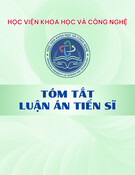
1
1
INTRODUCTION
1. Necessity of the research
At present, the majority of the Vietnam banking are
in the early stages of providing E-banking services. In
fact, many people in VietNam has not used all the tools
and banking services. People also tend to use online
services accounted for the higher rate. Development
services from around 2010, up to now 74% commercial
banks (commercial banks) to develop Internet Banking
services, 38% of commercial banks develop mobile
banking services. Research on the factors affecting the
intention to use Ebanking services of customers has been
studied by many domestic and foreign researchers and
research theories. Some researchers use theoretical
backgrounds such as TRA, TPB, TPR, TAM, and IDT.
Many factors influence the intention to use Ebanking
services such as ease of use, perceived usefulness,
perceived risk, innovative technology, ... Venkatesh's
UTAUT model (2003) developed more influential factors
such as social determinants, regulatory variables (gender,
experience, age, etc.) affect the intention to use the
service and the additional effects of the regulation to the
level of influence factors on the intention to use Ebanking
services.
Consumer behavior research on the basis of
consumer behavior theory also helps investors who are
more properly oriented in developing Ebanking services.

2
2
Recognizing the urgency, many Vietnamese researchers
have made some research results which mainly in the
form of articles, scientific paper, research journals,
research on Ebanking services in some different areas,
and most studies have not mentioned the impact of
elements. and most studies have not mentioned the
impact of elements. There is no difference in in the use of
services in the different regions, the perceived factors was
less interested in studies. The cost factor has not been
fully the theory while cost perception is one of the key
factors affecting the development of services.
Stemming from the above reasons, I chose the
topic: "Studying the intention to use Ebanking services of
customers at Vietnamese commercial banks" to do
research.
2. Researching Objectives
The research objectives were concretized by the
following questions:
- Factors affecting the intention to use Ebanking
services of customers? The impact of each factor to the
trend of using Ebanking service?
- How do demographic variables affect the impact
of factors on the intention to use Ebanking?
- Based on the results of the study, the author has
made some recommendations for commercial banks and
State banks, thus helping to increase customers and
develop Ebanking services.

3
3
3. Objects and scope of the research
3.1. Objects of research: The study subjects
consisted of two main subjects: Theoretical
considerations on factors affecting purchase intention and
the factors affecting the customers' intention to use
Ebanking services at commercial banks in Vietnam.
3.2. Scope of Research: Studying individual
customers in some cities: Hanoi, Ho Chi Minh City. The
study period: From 2015 to 2017.
3. Research Methodology
To achieve the research objectives, the topic uses a
combination of qualitative, quantitative, interview and
some models to study and analyze some relevant
contents.
5.Contributions of the thesis
The thesis accomplishes the objectives set out in the
study:
- An overview of the research on the intention to
use Ebanking services and the basic theory of behavioral
intentions that builds up the research model.
- Verification of research models, confirming the
hypotheses about the relationship between the factors
affecting the intention to use Ebanking services.
- From the research results, the thesis proposes
some suggestions for commercial banks to enhance their
intention to use Ebanking services and some macro

4
4
recommendations to promote the development of
Ebanking services in Vietnam.
6. Thesis structure
Besides introduction, conclusion, reference,
appendix, the main contents of this research are
represented in 5 chapters:
Chapter 1. The theoretical basis and research
overview of the intention to use Ebanking service.
Chapter 2. The current status of using Ebanking
services of customers in some commercial banks in
Vietnam
Chapter 3. Research Methods and Research Models
Chapter 4. Research of intention to use Ebanking
service at Vietnamese commercial banks.
Chapter 5. Conclusion and recommendations
CHAPTER 1: THEORETICAL BASIC AND
RESEARCH OVERVIEW
1.1. Ebanking
1.1.1. The concept of Ebanking
There are many different interpretations of the
concept of Ebanking. In English, Ebanking is Electronic
Banking, abbreviated to Ebanking. There are many
different expressions about "Ebanking". The most general
concept of Ebanking can be expressed as follows:
"Ebanking includes all types of transactions between
banks and customers based on the processing and transfer

5
5
of data digitization to provide banking" (Dr. Nguyen
Minh Kieu, 2007).
1.1.2. Intention to use banking services
In this study, the author uses the intention to
purchase as a willingness to use the customer's service
(Elbeck, 2008) to predict purchasing intent as an initial
step to predict the actual behavior of the customer
(Howard and Sheth, 1967) and the basis for predicting
future demand (Warshaw, 1980; Fishbein and Ajzen,
1975). Intention to use Ebanking service is understood as
motivation to take action, decision to accept or not accept
using Ebanking service in the future.
Research on the relationship between intention to
use the service and accept the use of services has a lot of
domestic and foreign researchers has launched many
theories prove and assert the factors that impact the
consumer behavior of the customers. However, in this
issue, the article only gives some important theories to
study the intention to accept and use the service of
consumers.
1.2. The basic theory of intention to use
Ebanking service
1.2.1. Theory of Reasoned Action (TRA)
The Rational Action Theory was developed by
Ajzen and Fishbein in 1967 and revised over time. The
TRA model (Ajzen and Fishbein, 1975) shows that
consumer trends are the best predictors of consumer


























